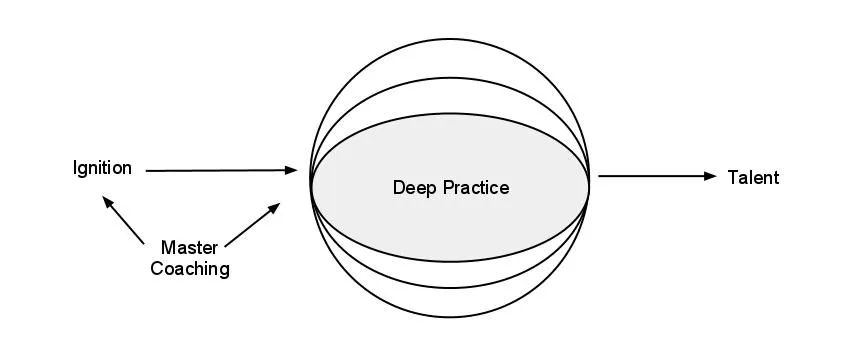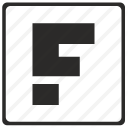The Talent Code notes

by daniel coyle
“Greatness isn’t born, it’s grown.”
The talent code is built on revolutionary scientific discoveries involving a neural insulator called myelin, which some neurologists now consider to be the holy grail of acquiring skill. Basically, a signal traveling through a circuit, Myelin’s vital role is to wrap those nerve fibers the same way that rubber insulation wraps a copper wire, making the signal stronger and faster by preventing the electrical impulses from leaking out. When we fire our circuits in the right way, when we practice something, our myelin responds by wrapping layers of insulation around that neural circuit, each new layer adding a bit more skill and speed. The thicker the myelin gets, the better it insulates, and the faster and more accurate our movements and thoughts become.
Deep practice is built on a paradox: struggling in certain targeted ways, operating at the edges of your ability, where you make mistakes, makes you smarter. Or to put it a slightly different way, experiences where you’re forced to slow down, make errors, and correct them, as you would if you were walking up an ice-covered hill, slipping and stumbling as you go, end up making you swift and graceful without your realizing it.
“We tend to think of our memory as a tape recorder but that’s wrong”, “It’s a living structure, a scaffold of nearly infinite size. the more we generate impulses, encountering and overcoming difficulties, the more scaffolding we build. The more scaffolding we build, the faster we learn.
The revolution is built on three simple facts.
- Every human movement, thought, or feeling is a precisely timed electric signal traveling through a chain of neurons, a circuit of nerve fibers.
- Myelin is the insulation that wraps these nerve fibers and increases signal strength, speed, and accuracy.
- The more we fire a particular circuit, the more myelin optimizes that circuit, and the stronger, faster, and more fluent our movements and thoughts become.
Skill is myelin insulation that wraps neural circuits and that grows according to certain signals.
All actions are really the result of electrical impulses sent along chains of nerve fibers. Basically, our brains are bundles of wires, 100 billion wires called neurons, connected to each other by synapses. Whenever you do something, your brain sends a signal through those chains of nerve fibers to your muscles. Each time you practice anything, sing a tune, swing a club, or read this sentence, a different highly specific circuit lights up in your mind.
The more we develop a skill circuit, the less we’re aware that we’re using it. We’re built to make skills automatic, to stash them in our unconscious mind. This process, which is called automaticity, exists for powerful evolutionary reasons. (The more processing we can do in our unconscious minds, the better our chances of noticing that saber-toothed tiger lurking in the bush). It also creates a powerfully convincing illusion: a skill, once gained, feels utterly natural, as if it’s something we’ve always possessed. These 2 insights, skills such as brain circuits and automaticity, create a paradoxical combination: We’re forever building vast, intricate circuits, and simultaneously forgetting that we built them. Which is where myelin comes in.
Myelin operates by a few fundamental
- The firing of the circuit is paramount. The mechanism is built to respond to actions, the literal electrical impulses traveling down nerve fibers. It responds to urgent repetition.
- Myelin is universal. Regardless of its use, it grows according to the same rules. Circuit that fire gets insulated, it doesn’t care who you are, it cares what you do.
- Myelin wraps - it doesn’t unwrap. Once a skill circuit is insulated, you can’t un-insulate it (except through age or disease), that’s why habits are hard to break. The only way to change them is to build new habits by repeating new behaviors, by myelinating new circuits.
- Age matters. In children, myelin arrives in a series of waves, some of them determined by genes, some dependent on activity. The waves last into our thirties, creating critical periods during which time the brain is extraordinarily receptive to learning new skills.
A universal theory of skill that can be summed up in a concise equation: deep practice x 10000 hours = world-class skill.
They had one thing in common, they all spent thousands of hours inside a deep-practice, hothouse, firing and optimizing circuits, correcting errors, competing, and improving skills, they each took part in the greatest work of art anyone can construct: the architecture of their own talent.
Skills consist of identifying important elements and grouping them into a meaningful framework. The name psychologists use for such an organization is chunking.
Chunking takes place in 3 dimensions, 1st look at the task as a whole, as one big chunk, the megacircuit. 2nd divide it into its smallest possible chunks. 3rd play with time, slowing the action down, then speeding it up, to learn its inner architecture.
Why does slowing down work so well, 1st Going slow allows you to attend more closely to errors, creating a higher degree of precision with each firing, and when it comes to growing myelin, precision is everything.
Experts practice differently and far more strategically, when they fail, they don’t blame it on luck or themselves. They have a strategy they can fix.
Biologically speaking, no substitute for attentive repetition. Nothing you can do, talking, thinking, reading, imagining, is more effective in building skill than executing the action, firing the impulse down the nerve fiber, fixing errors, and honing the circuit.
a vivid picture of what deep practice feels like of being a staggering baby, of intently, clumsily lurching toward a goal and toppling over. It’s a wobbly, discomfiting sensation that any sensible person would instinctively seek to avoid. Yet the longer the babies remained in that state, the more willing they were to endure it, and to permit themselves to fail, the more myelin they built, and the more skill they earned.
Deep practice is not a piece of cake, it requires energy, passion, and commitment. it requires motivational fuel and the second element of the talent code called Ignition. Ignition and deep practice work together to produce skill.
While deep practice is cool, ignition is hot, mysterious burst, an awakening. deep practice is an incremental wrapping, ignition works through lightning flashes of image and emotion, evolution-built neural programs that tap into the mind’s vast reserves of energy and attention. Where deep practice is all about staggering baby steps, ignition is about the set of signals and subconscious forces that create our identity, the moment that leads us to say “That is who I want to be”.
What ignited the progress wasn’t any innate skill or gene. It was a small, ephemeral, yet powerful idea: a vision of their ideal future selves, a vision that oriented, energized, and accelerated progress, and that originated in the outside world.
What do these signals have in common? Each has to do with identity and groups, and the links that form between them. Each signal is the motivation equivalent of a flashing red light: those people over there are doing something terrifically worthwhile. Each signal, in short, is about future belonging. Future belonging is a primal cue: a simple, direct signal that activates our built-in motivational triggers, funneling our energy and attention toward a goal. the idea makes intuitive sense, we’ve all felt motivated by the desire to connect ourselves to high-achieving groups.
Losing a parent at a young age was not what gave them talent, rather, it was the primal cue, you are not safe. by tripping the ancient self-preserving evolutionary switch, provided energy for their efforts, so that they build their various talents over the course of years, step by step, wrap by wrap.
Universal principles that govern all of us.
- Talent requires deep practice
- deep practice requires vast amounts of energy
- primal cues trigger huge outpourings of energy.
A character might be more like a skill, ignited by certain signals, and honed through deep practice.
Master coaches taught in chunks, using what he called the “whole part method” he would teach an entire mote and then break it down to work on its elemental actions. Explanation, demonstration, imitation, correction, and repetition. “Don’t look for the big, quick improvement. Seek the small improvement one day at a time. That’s the only way it happens, and when it happens, it lasts”
“The importance of repetition until automaticity cannot be overstated” ”Repetition is the key to learning”
Master coaches are the human delivery system for the signals that fuel and direct the growth of a given skill circuit, telling it with great clarity to fire here not here. Coaching is a long, intimate conversation, a series of signals and responses that move toward a shared goal. A coach’s true skill consists not in some universally applicable wisdom that he can communicate to all but rather in the supple ability to locate the sweet spot on the edge of each individual student’s ability and to send the right signal to help the student reach toward the right goal, over and over.
“If it’s a choice between me telling them to do it, or them figuring it out, I’ll take the second option everytime” “You’ve got to make the kid an independent thinker, a problem solver” The point is they’ve got to figure things out for themselves.
The useful thing about this model is that it’s as flexible as myelin itself, applying to all skills, in contexts as small as families and as large as nation. It also highlights the importance of seeking new challenges. Experiments have found that situations in which people are forced to adapt and attune themselves to new challenges (ex, make errors, pay attention, deep practice) tend to increase cognitive reserve.
Parenting advice: pay attention to what your children are fascinated by, and praise them for their effort.
